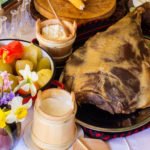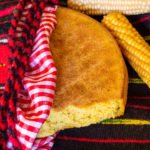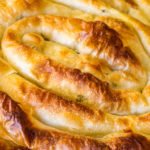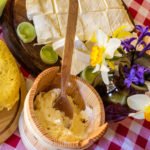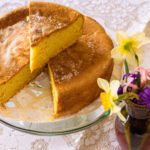- /
- Katun Road Borderline Heights
- /
- Services
- /
- Homemade Food
Homemade Food
The best things are always simple. The food in katuns is simple and caloric but above everything else – it’s organic. There’s no place on earth where you can eat food as healthy as here. The secret is in full compatibility of a man with nature he depends on and respects, and which gives him everything he needs.
Dairy products and bread, made of corn or wheat, together with everything that grows on the mountain or is planted close to a cottage are the foundation of this cuisine.
Home-made plum brandy and fresh cottage cheese are the first things a mountain woman will offer to her guest in katun, even in the break of dawn. Then, she prepares kačamak or cicvara, greens pie. For lunch, potato with cooked smoked meat (prosciutto) or beans, although dinner is the main meal in katun due to whole-day working. Just before dusk, everyone returns from different sides, they get together for dinner and share day’s events.
Everything is home-made
Besides plum brandy, all the other brandies are home-made, such as apple brandy or pear brandy. Gentian brandy or juniper brandy are considered to be a medicine. The juices are home-made too and without any additives, for example a blueberry one or the one made from pinecones. The tea can be brewed from fresh herbs that are all around you: thyme, rosehips, yarrow, St. John’s Wort … or from the ones already collected and dried.
A Miniature on bread
Centuries went by before some wise man invented a stove and the first peasant loaded it in his horse cart and brought it home to his cottage.
Today’s life of mountain women is much easier. Once, they had to walk a long way to the spring and bring water. Then they had to light a fire in the stone slabs fireplace and make barley or corn bread. They would then wrap it up in the butterbur leaves and place it carefully onto coals mixed with ashes to bake.
Cheese and kaymak (cream), skorup
You have to make your own decision when it comes to its taste, and facts talk about its quality. Sheep and cows are free beings here, they walk freely in the sun, they enjoy the fresh air and they graze the abundance of herb types, many of which are medicinal. They can even choose the water they drink and the shade they rest upon.
From their milk, which is hand-milked, housewives make cheese and kaymak using ancient instructions, taking care of hygiene and temperature in the cottage. Sorted in circles or squares into yellow vats, pressed with a large stone and covered by white cheesecloth, the cheese matures into a premium product.
Skorup is the type of kaymak, a matured one. It can be full of fat, but this kind of highly caloric food is excellent after some hard labor.
Jardum
If you are offered jardum, a beverage made of sheep milk, try it but don’t take too much because it’s very strong. The best time to make it is after St. Peter’s day (July 12). Sheep milk is boiled and stirred constantly till it forms foam. Then you remove it from the stove and add some salt.
Cicvara and gotovac
They used to honor their guests by making cicvara or gotovac. There are some places where they think these two are one and the same dish made of corn flour, but some mountain women explain there is a difference. According to them, when you add flour to a melted fresh cottage cheese you get cicvara and when you melt skorup (matured kaymak) in the heat, add flour and some yoghurt in the end only to separate the fat in a circle while stirring – that is gotovac.
Nettle
Mountain women are very skillful in making different types of pies, especially the ones with greens. They use wild plants for their pies: nettle, pigweed, bitter dock, sorrel. They often combine them, whichever they find and mix them with cheese and kaymak. Served with home-made yoghurt, it is a real treat as well as a source of strength and health.
The latest research have confirmed the fact known for centuries in a katun: the nettle is a magical plant, full of iron, magnesium, potassium, vitamins …
Nettle porridge
This dish is so easy to make that you can make it yourself in the camp. Pick a lot of early nettle (that haven’t effloresced), cook it in the fireplace, squeeze the surplus of water and chop it finely. Return the nettle to the pot, pour some water, as much as it’s necessary to make a porridge. When the water with nettle boils, add some corn flour slowly. Stir at times. When the porridge is ready, while still on fire, add some skorup or crumbled cheese. As with every porridge – this one is also eaten hot.
Potato
In a small garden, next to their cottage, mountain women plant some onion, potato, cabbage, mangel. All these things have a better, special taste here. A hot potato baked with its shell, in a stove or a fireplace, halved by hand and flavored with some kaymak taken from the boiled milk is one of the tastes whose delight seasoned many childhoods.
When the potato is baked in oven or under the bell, it can be sliced, salted, flavored with some fat and a lot of milk.
Lamb
Meat is eaten rarely in a katun, usually during a holiday or when important guests come. In these situations, lamb is usually made, baked on live coals, on a spit. There is a reason for this – an honor for the chosen ones.


